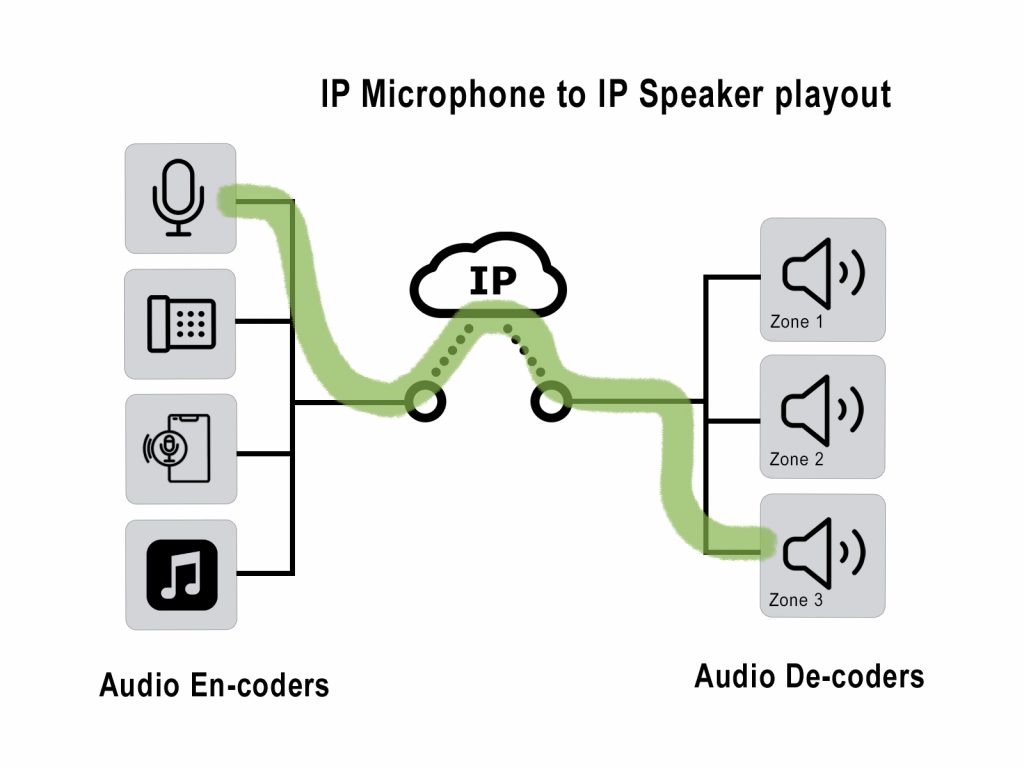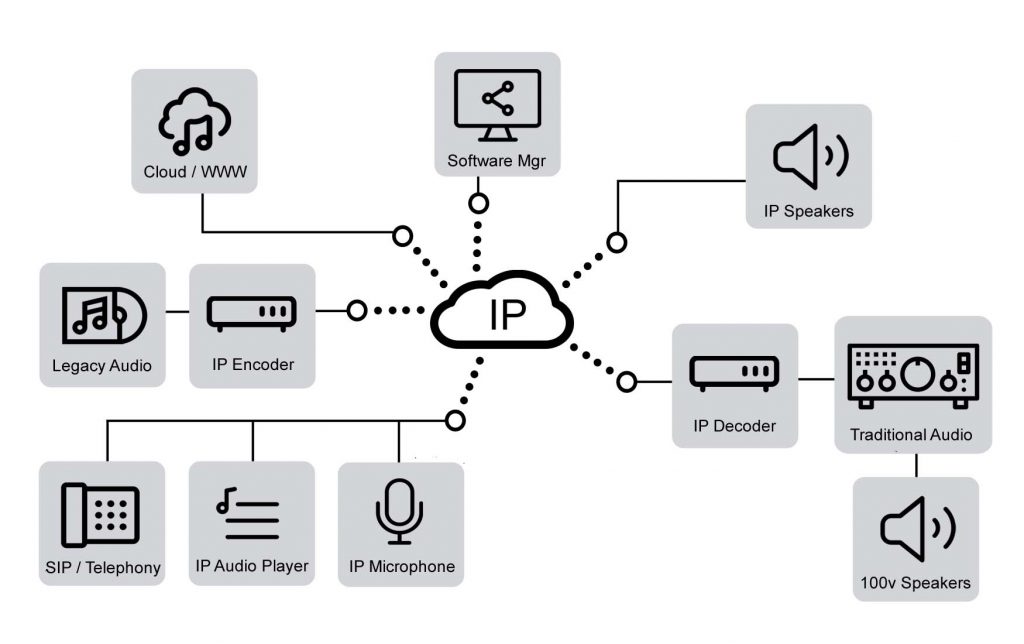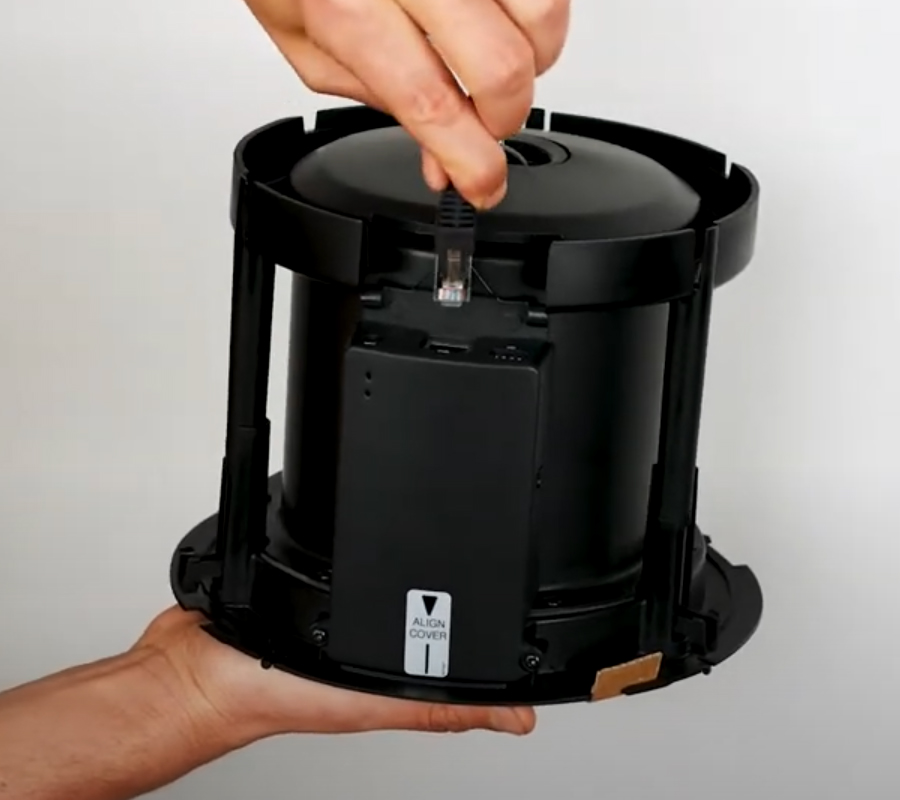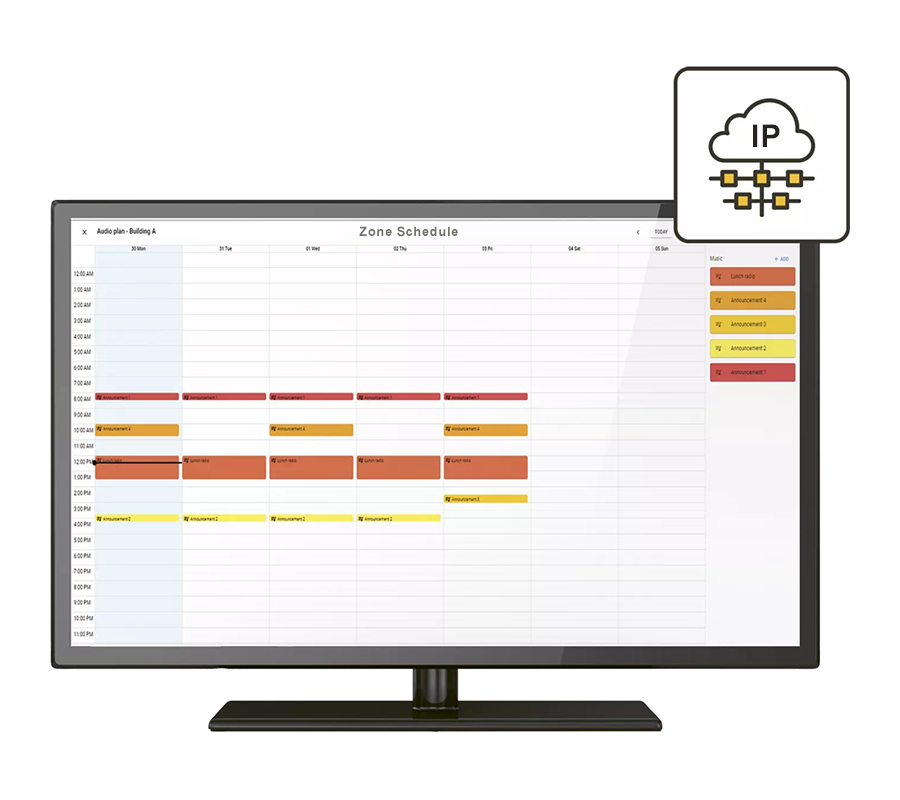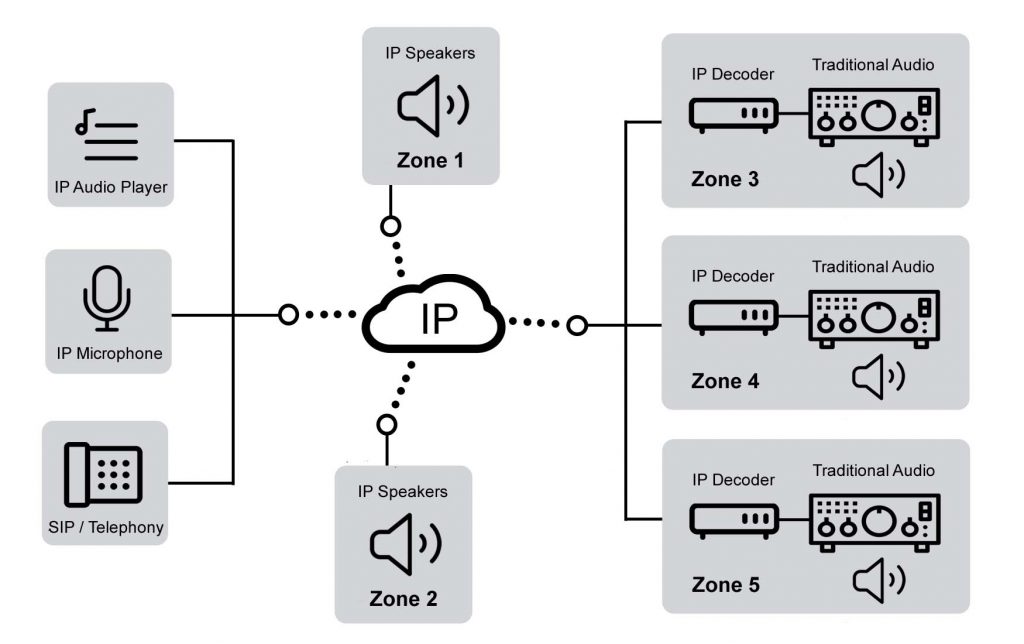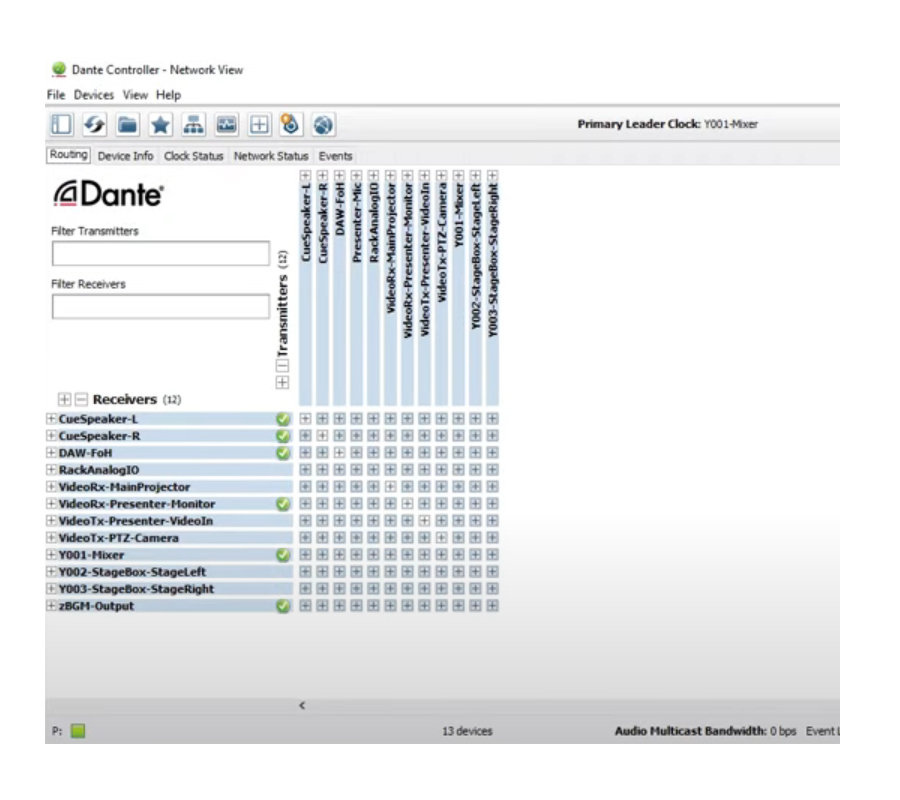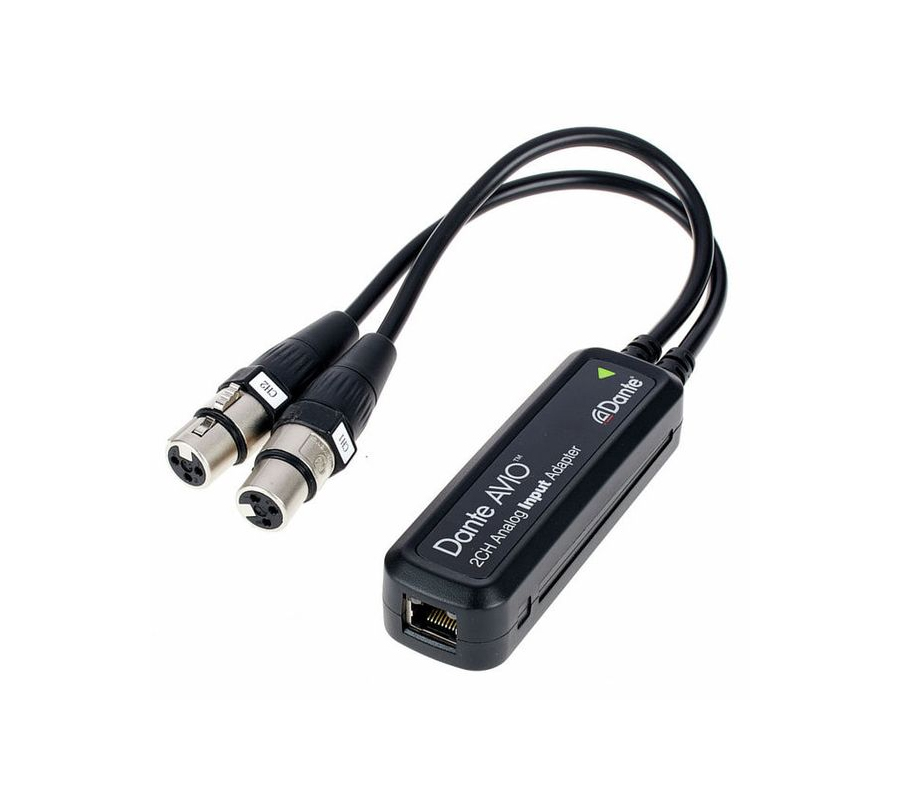Audio over IP (AoIP)
Audio over IP offers functional capability and scalability with flexible topology design options not found with traditional audio design and technologies.
What is Audio over IP?
AoIP = Audio over Internet Protocol.
Audio over IP or ‘AoIP’ is a digital coding and encapsulation process used for the transmission of audio via IP based network infrastructures. ‘Network Audio’ and ‘IP audio’ are terms used interchangeably with ‘AoIP’ in describing this process.
Encoded IP audio is transmitted ‘over’ IP via the local network between IP audio input devices and IP speakers. A very basic example would be an IP microphone which en-codes audio for streaming AoIP to an IP speaker. The IP speaker receives the stream and de-codes the audio for local playout.
The transmission and audio communication path between AoIP device entities is not fixed like traditional audio which requires dedicated cabling. Removing this restriction, enables AoIP audio topology and design options which are not possible with traditional audio (eg. improved scalability and installation / deployment flexibility).
AoIP audio ‘entities’ connect to the local network via ethernet cables, which in turn connect to a network switch. The audio connection path is no longer physically connected. Audio streams logically connected from end to end (streaming audio over IP). AoIP therefore offers improved scalability and flexibility for audio routing as well as integration with other network connected audio equipment and 3rd party entities.
Example AoIP device entities:
- Source & Input Entities: IP Microphones, Music source, Message players, Mobile apps
- Audio Processing Entities: Audio server, Software, Firmware
- Interfaces & Input / Output (I/O) Entities: IP Relays, CCTV & Access Control, BYOD, IP Automation
- Playout Entities: IP Decoders, IP Speakers
AoIP and commercial audio applications
Just like any new project interfacing and communicating on a local network, there are obviously some technical and network infrastructure requirements to consider with AoIP. For example, investment in additional network switches/ports; new ethernet cabling to proposed IP speaker locations… Or, perhaps new Power over Ethernet (PoE) requirements for powering AoIP device entities and IP speakers. Once considered and resolved, installation and deployment of an AoIP system becomes a relatively simple plug and play exercise in most cases.
Example benefits we see with using AoIP in commercial audio applications:
Audio Distribution
For installed audio systems, traditionally fixed audio distribution and speaker zone cabling can limit audio design options and present a challenge to distribution topology. This is particularly true for larger installations with lots of audio zones, sites with multiple buildings (eg. campus) or when flexible audio distribution is required (regular zone changes).
AoIP offers an alternative (or additional) audio distribution option. Connecting audio systems, devices and speakers to an ethernet network infrastructure offers improved scalability and flexibility for audio designs and installation topologies.
Example topology: 2 x buildings, 16 zones design using Dante AoIP for audio distribibution.
Simple, flexible installation options
After provisioning of the local network infrastructure has been made, AoIP device entities and IP speakers installation is basically plug & play. Electrical power delivery to the device is normally via the same cable using power over ethernet (PoE), resulting in a single cable connection to each AoIP device / IP speaker.
Future additions or changes to AoIP device locations (eg. moving an IP microphone or some IP speakers), does not require rewiring of audio speaker line / zone cables like traditional audio. AoIP devices can simply be moved and plugged into new network switch port outlets. There will of course be some associated network configuration changes to accommodate these changes (typically subnet/VLAN assignment). However, these changes are basic network adds, moves and changes that occur regularly for network administrators.
Flexible routing and audio 'Zones'
Audio ‘zones’ allow playout different audio or music to different groups of speakers (typically on a room, area of building basis). For example, we might see the lobby of a hotel playing out different music to the bar or restaurant areas.
We can of course create and install audio zones with a traditionally installed audio system. However, with fixed zone speaker cabling, it is not possible to alter the speaker zone assignment without re-engineering the cabling. IP speakers are connected to the local network infrastructure and don’t have a fixed communication path. This allows simple changes to speakers and zone assignment through firmware/software – without any cable re-engineering. In fact, IP speakers can belong to multiple audio zones at the same time, providing excellent routing and zone flexibility.
Audio control & system management
With AoIP system and device entities connected to the network, this offers user and system administrators simple access via graphical user interface (GUI). Typical GUI options include dedicated software, or more popularly, via mobile apps and browser based web apps.
System Admin: will usually have a separate login account to perform administrative functions, such as adding or changing device assignment or changing audio routing and zone assignments.
User Access: multiple user accounts offer different levels of control over the audio system. For example, a ‘power user’ account may allow control over music content. A standard ‘user’ user account may only allow basic local control for a particular area or zone, eg. audio source selection and volume level.
Combining AoIP and traditional audio
As we have seen, commercial audio installation projects employ AoIP to improve functionality and capability. Some new commercial audio installation projects may even use AoIP exclusively. However, it is important to acknowledge and recognise that for various reasons, AoIP may not be the ‘best fit’ audio technology for some projects. For a start, we must consider the huge installation base of existing traditional commercial audio (legacy) installations. For smaller sites, sites with limited network infrastructure or for audio designs only requiring very basic function/capability, traditional audio is likely to remain an attractive cost effective technology option.
For many projects, combining ‘both’ audio technologies to benefit from the innovation and capability of AoIP with the large and established traditional audio markets can offer a powerful proposition for many commercial audio installation projects.
Combined audio technology - design example
Most of our new audio installation project designs will use AoIP and traditional audio technologies. This offers a great proposition, balancing improved capability and function against overall project cost.
This example design shows three AoIP audio inputs (music player, microphone and SIP telephony). We see a total of five audio zones. Two zones contain AoIP / IP speakers. Three zones use an IP decoder to interface to traditionally amplified speaker communities.
AoIP and Dante
What is Dante?
Dante was developed in 2006 by Audiante, an Australian based AV technologies provider, to offer an AoIP ecosystem of hardware and software to deliver network based audio connections.
Dante or Digital Audio Network Through Ethernet, builds upon existing AoIP standards and protocols to deliver high quality, low latency audio distribution over ethernet networks. With continued development, Audinate introduced Dante AV and support for a complete integrated audio and video networking solution at ISE in 2019.
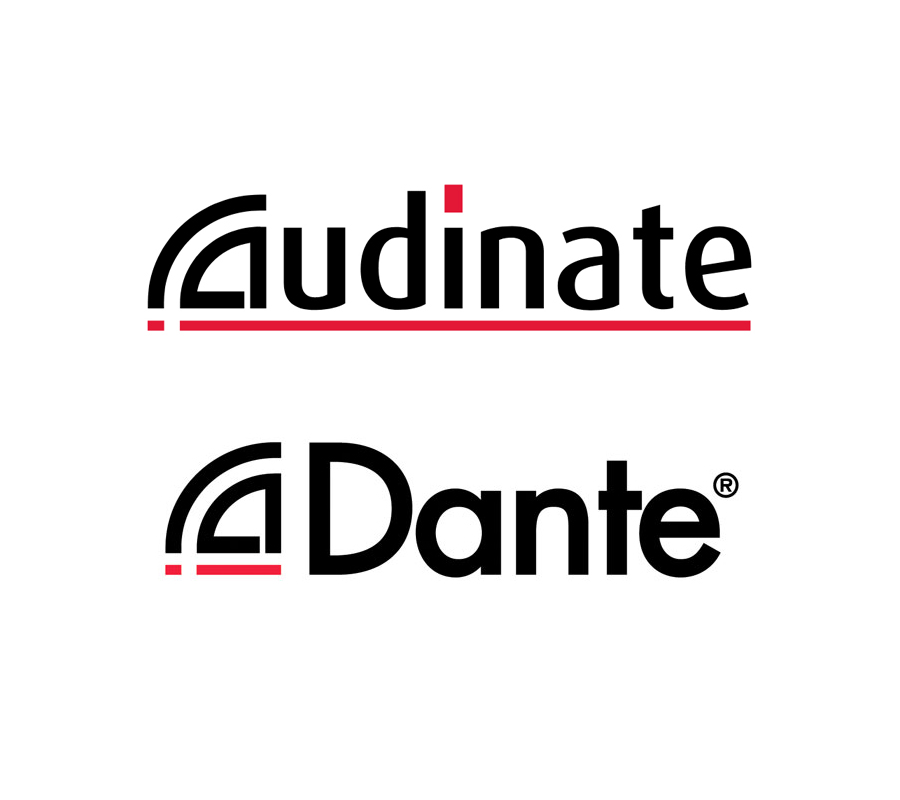
Dante and commercial AoIP
As we have seen, commercial AoIP continues to offer improved flexibility and capability to many commercial audio projects and system designs. Almost all of our own new installed audio projects will employ AoIP to a small or large extent. Doing so will depend on a number of factors, but ‘how’ we use AoIP and the design options available to us can be largely discussed across two AoIP market sectors as follows.
AoIP & audio 'solutions' providers
This section of the AoIP market typically offers single vendor integrated ‘solution’ packages, including firmware, software and hardware for audio designers to create a range of audio applications for their customers. This popular AoIP option offers a powerful proposition, with excellent features and functionality. However, to achieve this level of capability, the AoIP entities, and supporting management firmware/software generally integrate using non-standard bespoke communication. As a result, multi-vendor integration and interoperability between vendors is therefore often limited or in some cases, not possible.
Dante AoIP
Dante differentiates itself from AoIP system ‘solutions’ providers, by focusing on AV connectivity, providing a framework for connection based, multi-channel, digital audio over a standard IP over Ethernet network. Little focus is given to the end user function or application, these are onwardly provided by ‘Dante connected’ devices themselves. A good use case example for Dante would be a studio transmission link – using multi-channel audio (and video) routed and connected via ethernet network.
Audinate works with 3rd party AV developers and manufacturers to licence and embed dante capability within their audio products and devices. The list of manufacturers offering ‘Dante ready’ integration and connectivity has grown rapidly. Recent figures show over 600 manufacturers now support Dante with over one million hardware/software units shipped in 2023. Dante itself does not share the same level function or user capabilities offered by single solution AoIP vendors. However, Dante is fast becoming the AV connection of choice for AV providers to base interconnectivity for their solutions and designs.
We employ Dante within many of our commercial audio designs. Mostly, this will be for core routing and distribution of audio using AoIP across a site or between buildings. However, with Dante capability extending deeper into audio device entities and peripherals, we can also look to specify and use Dante right up to the end audio point, eg. Dante wall plate, Dante conference unit, Dante microphone or Dante speaker.
want to know more about aoip?
Get in touch to discuss AoIP and your commercial audio project. General enquiry or detailed project specification, we are here to advise, help and provide support.


